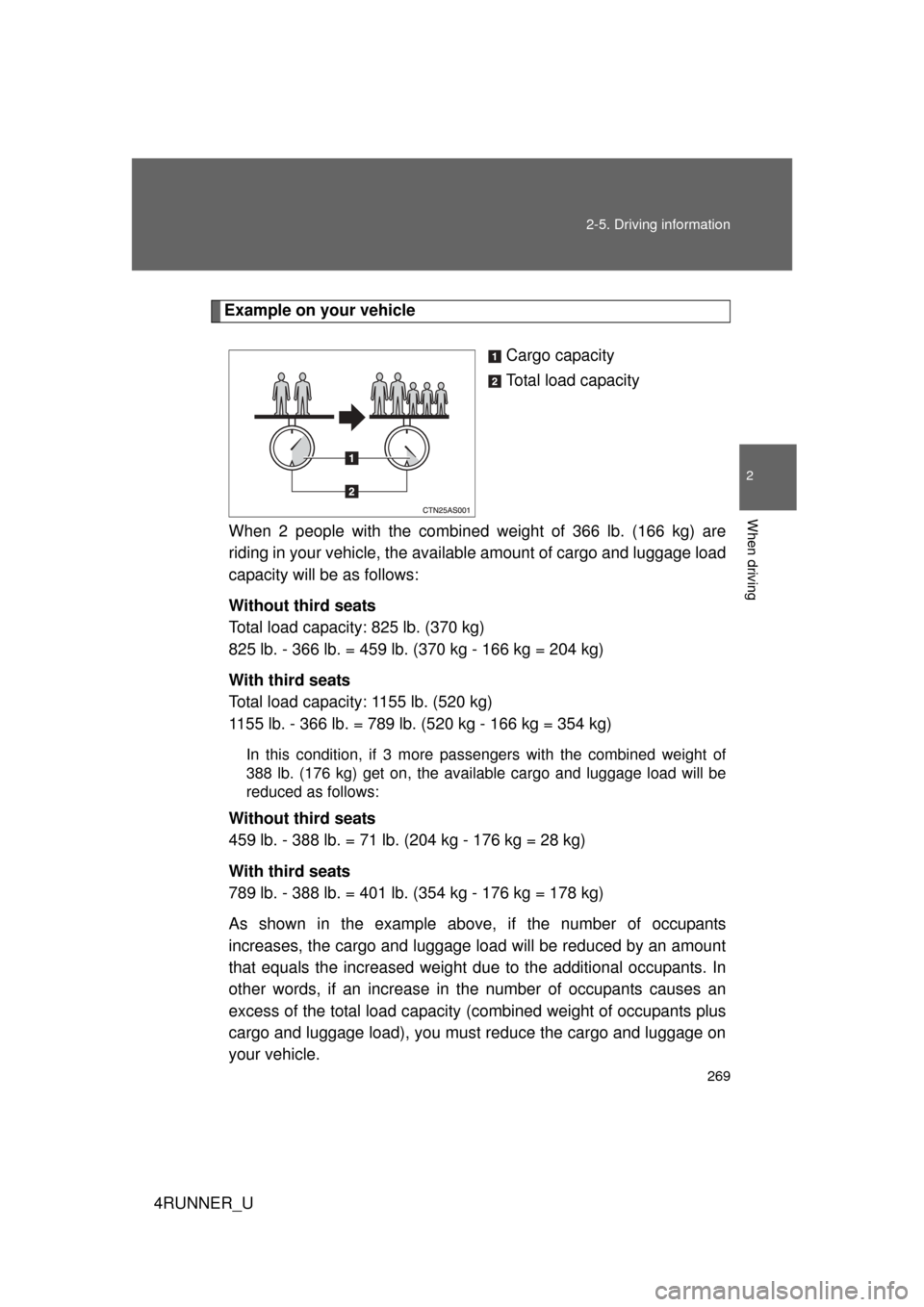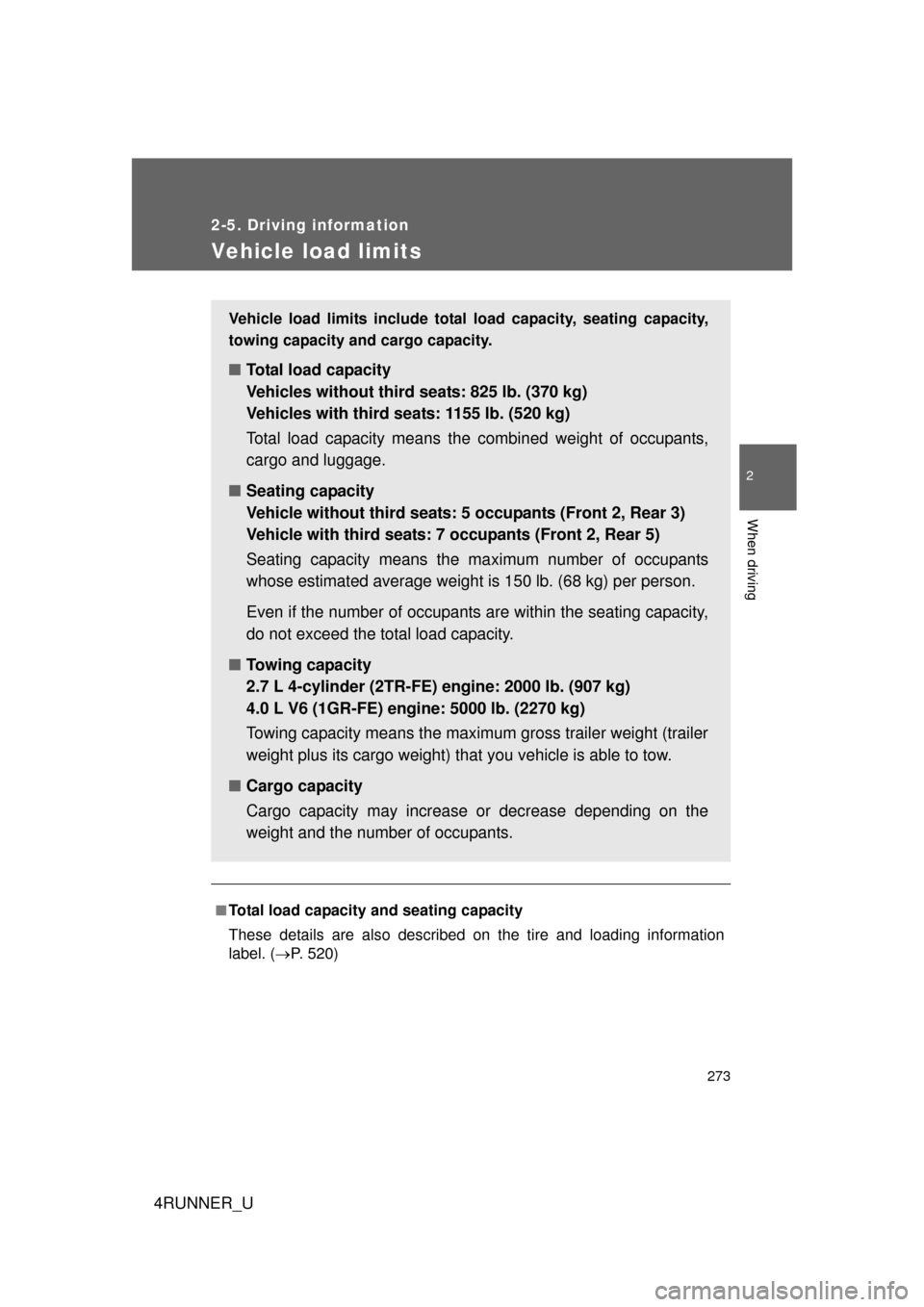Page 261 of 665

261
2-4. Using other
driving systems
2
When driving
4RUNNER_U
CAUTION
■When the VSC is activated
The slip indicator light flashes and a warning buzzer sounds. Always drive
carefully.
Reckless driving may cause an accident. Exercise particular care when the
indicator light flashes and a buzzer sounds.
■ When TRAC (TRC)/VSC systems are turned off
Be especially careful and drive at a speed appropriate to the road condi-
tions. As these are systems to ensure vehicle stability and driving force, do
not turn the TRAC (TRC)/VSC systems off unless necessary.
■ Replacing tires
Make sure that all tires are of the specified size, brand, tread pattern and
total load capacity. In addition, make sure that the tires are inflated to the
recommended tire inflation pressure level.
The ABS, Multi Terrain ABS and VSC will not function correctly if different
tires are fitted on the vehicle.
Contact your Toyota dealer for further information when replacing tires or
wheels.
■ Handling of tires and the suspension
Using tires with any kind of problem or modifying the suspension will affect
the driving assist systems, and may cause a system to malfunction.
Page 267 of 665
267
2-5. Driving information
2
When driving
4RUNNER_U
Cargo and luggage
Take notice of the following information about storage precau-
tions, cargo capacity and load:
●Stow cargo and luggage in the luggage compartment whenever
possible.
● Be sure all items are secured in place.
● To maintain vehicle balance while driving, position luggage
evenly within the luggage compartment.
● For better fuel economy, do no t carry unnecessary weight.
Page 268 of 665

268 2-5. Driving information
4RUNNER_U
Capacity and distributionCargo capacity depends on the total weight of the occupants.
(Cargo capacity) = (Total load capa city) — (Total weight of occupants)
Steps for Determining Correct Load Limit—
(1) Locate the statement “The co mbined weight of occupants and
cargo should never exceed XXX kg or XXX lbs.” on your vehi-
cle’s placard.
(2) Determine the combined weight of the driver and passengers that will be riding in your vehicle.
(3) Subtract the combined weight of the driver and passengers from
XXX kg or XXX lbs.
(4) The resulting figure equals the available amount of cargo and luggage load capacity.
For example, if the “XXX” amount equals 1400 lbs. and there will
be five 150 lb passengers in your vehicle, the amount of avail-
able cargo and luggage load capacity is 650 lbs. (1400 - 750 (5
150) = 650 lbs.)
(5) Determine the combined weight of luggage and cargo being loaded on the vehicle. That weight may not safely exceed the
available cargo and luggage load capacity calculated in Step 4.
(6) If your vehicle will be towing a trailer, load from your trailer will be transferred to your vehicle. Consult this manual to determine
how this reduces the available cargo and luggage load capacity
of your vehicle. ( P. 610)
Page 269 of 665

269
2-5. Driving information
2
When driving
4RUNNER_U
Example on your vehicle
Cargo capacity
Total load capacity
When 2 people with the combined weight of 366 lb. (166 kg) are
riding in your vehicle, the ava ilable amount of cargo and luggage load
capacity will be as follows:
Without third seats
Total load capacity: 825 lb. (370 kg)
825 lb. - 366 lb. = 459 lb. (370 kg - 166 kg = 204 kg)
With third seats
Total load capacity: 1155 lb. (520 kg)
1155 lb. - 366 lb. = 789 lb. (520 kg - 166 kg = 354 kg)
In this condition, if 3 more pa ssengers with the combined weight of
388 lb. (176 kg) get on , the available cargo and luggage load will be
reduced as follows:
Without third seats
459 lb. - 388 lb. = 71 lb. (204 kg - 176 kg = 28 kg)
With third seats
789 lb. - 388 lb. = 401 lb. (354 kg - 176 kg = 178 kg)
As shown in the example above , if the number of occupants
increases, the cargo and luggage load will be reduced by an amount
that equals the increased weight du e to the additional occupants. In
other words, if an increase in th e number of occupants causes an
excess of the total load capacity (combined weight of occupants plus
cargo and luggage load), you must reduce the cargo and luggage on
your vehicle.
Page 271 of 665

271
2-5. Driving information
2
When driving
4RUNNER_U
CAUTION
■Capacity and distribution
●Do not exceed the maximum axle weight rating or the total vehicle
weight rating.
●Even if the total load of occupant’s weight and the cargo load is less
than the total load capacity, do no
t apply the load unevenly. Improper
loading may cause deterioration of st eering or braking control which
may cause death or serious injury.
■Roof luggage carrier precautions
To use the roof rails as a roof luggag e carrier, you must fit the roof rails
with two or more genuine Toyota cross rails or their equivalent.
When you load cargo on the roof luggage carrier, observe the following:
●Before driving, make sure the cargo is securely fastened on the roof
luggage carrier.
●Loading cargo on the roof luggage carrier will make the center of grav-
ity of the vehicle higher. Avoid high speeds, sudden starts, sharp turns,
sudden braking or abrupt maneuvers, otherwise it may result in loss of
control or vehicle rollover due to failure to operate this vehicle correctly
and result in death or serious injury.
●If driving for a long distance, on rough roads, or at high speeds, stop
the vehicle now and then during the trip to make sure the cross rails
are fixed securely and that the cargo remains in its place.
●Do not exceed 120 lb. (54 kg) cargo weight on the roof luggage carrier.
●Place the cargo so that its weight is
distributed evenly between the front
and rear axles.
●If loading long or wide cargo, never
exceed the vehicle overall length or
width.( P. 610)
CTH25AS005
Cross rails
Roof rails
Page 273 of 665

273
2-5. Driving information
2
When driving
4RUNNER_U
Vehicle load limits
■Total load capacity and seating capacity
These details are also described on the tire and loading information
label. (P. 520)
Vehicle load limits include total load capacity, seating capacity,
towing capacity and cargo capacity.
■ Total load capacity
Vehicles without third seats: 825 lb. (370 kg)
Vehicles with third seats: 1155 lb. (520 kg)
Total load capacity means the combined weight of occupants,
cargo and luggage.
■ Seating capacity
Vehicle without third seats: 5 occupants (Front 2, Rear 3)
Vehicle with third seats: 7 occupants (Front 2, Rear 5)
Seating capacity means the ma ximum number of occupants
whose estimated average weight is 150 lb. (68 kg) per person.
Even if the number of occupants are within the seating capacity,
do not exceed the total load capacity.
■ Towing capacity
2.7 L 4-cylinder (2TR-FE) engine: 2000 lb. (907 kg)
4.0 L V6 (1GR-FE) engine: 5000 lb. (2270 kg)
Towing capacity means the maximum gross trailer weight (trailer
weight plus its cargo weight) that you vehicle is able to tow.
■ Cargo capacity
Cargo capacity may increase or decrease depending on the
weight and the number of occupants.
Page 281 of 665
281
2-5. Driving information
2
When driving
4RUNNER_U
Weight limits
Confirm that the gross trailer weight, gross combination weight, gross
vehicle weight, gross axle weight and trailer tongue load are all within
the limits.
● The gross trailer weight must never exceed towing capacity
described in the table above.
● The gross combination weight must never exceed the GCWR
described in the table above.
●The gross vehicle weight must
never exceed the GVWR indi-
cated the Certification Label.
● The gross axle weight on each
axle must never exceed the
GAWR indicated the Certifica-
tion Label.
EngineDriving
systemTowing
capacityGCWR
2.7 L 4-cylinder
(2TR-FE) engine 2WD2000 lb.
(907 kg) 7900 lb. (3583 kg)
4.0 L V6 (1GR-FE) engine 2WD
5000 lb.
(2270 kg) 11100 lb. (5035 kg)
4WD 11300 lb. (5125 kg)
CTH61AS002
Page 282 of 665

282 2-5. Driving information
4RUNNER_U
Towing related terms
Towing related termMeaning
GVWR (Gross Vehicle Weight
Rating) The maximum allowable gross vehicle
weight. The gross vehicle weight is the
total weight of the vehicle. When towing
a trailer, it is the sum of the vehicle
weight (including the occupants, cargo
and any optional equipment installed on
the vehicle) and the tongue load.
GAWR (Gross Axle Weight
Rating) The maximum allowable gross axle
weight. The gross axle weight is the
load placed on each axle (front and
rear).
GCWR (Gross Combination
Weight Rating) The maximum allowable gross combi-
nation weight. The gross combination
weight is the sum of the total vehicle
weight (including the occupants, cargo
and any optional equipment installed on
the vehicle) and the weight of the trailer
being towed (including the cargo in the
trailer).
Gross trailer weight The sum of the trailer weight and the
weight of the cargo in the trailer.
Towing capacity The maximum allowable gross trailer
weight. Towing capacity is calculated
considering the base vehicle with nec-
essary vehicle equipment and occu-
pants. Additional optional equipment,
passengers and cargo in the vehicle will
reduce the towing capacity, gross trailer
weight include the trailer, cargo and
necessary equipment for towing.
Tongue load The load placed on the trailer hitch ball